
Eupatorium is a genus of flowering plants in the family Asteraceae, containing from 36 to 60 species depending on the classification system. Most are herbaceous perennials growing to 0.5–3 m (1.6–9.8 ft) tall. A few are shrubs. The genus is native to temperate regions of the Northern Hemisphere. Most are commonly called bonesets, thoroughworts or snakeroots in North America. The genus is named for Mithridates Eupator, king of Pontus.

The family Stylidiaceae is a taxon of dicotyledonous flowering plants. It consists of five genera with over 240 species, most of which are endemic to Australia and New Zealand. Members of Stylidiaceae are typically grass-like herbs or small shrubs and can be perennials or annuals. Most species are free standing or self-supporting, though a few can be climbing or scrambling.

Oenothera lindheimeri, commonly known as Lindheimer's beeblossom, white gaura, pink gaura, Lindheimer's clockweed, and Indian feather, is a species of Oenothera. Several of its common names derive from the genus Gaura, in which this species was formerly placed.
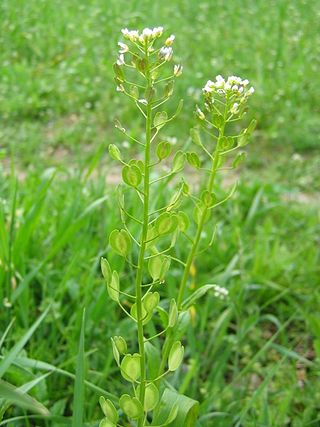
Thlaspi, or pennycress, is a genus of herbs of temperate regions of the Eurasian continent. They occur in Central and South Europe, South-West Asia and two species are endemic to China. The Thlaspi has been proven to be a hyperaccumulator of heavy metals such as zinc and cadmium and therefore may be used in phytoremediation initiatives.

Thlaspi arvense, known by the common name field pennycress, is a flowering plant in the cabbage family Brassicaceae. It is native to Eurasia, and is a common weed throughout much of North America and its home.

Microseris is a genus of plants in the tribe Cichorieae within the family Asteraceae, plants that often called composites. They are native to North America, South America, Australia, and New Zealand.

Centrosema, the butterfly peas, is a genus of American vines in the legume family (Fabaceae). It includes 44 species, which range through the tropical and warm-temperate Americas from the southern United States to northern Argentina. Species include:
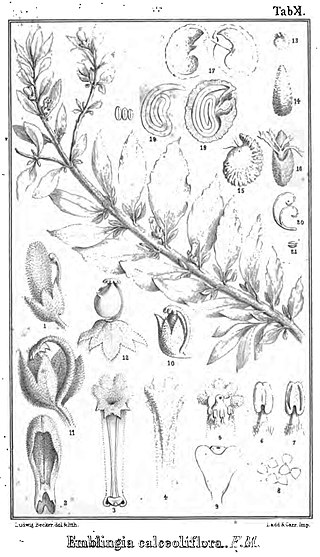
Emblingia is a monospecific plant genus containing the species Emblingia calceoliflora, a herbaceous prostrate subshrub endemic to Western Australia. It has no close relatives, and is now generally placed alone in family Emblingiaceae.
Stylidium dunlopianum is a dicotyledonous plant that belongs to the genus Stylidium. It is an erect perennial plant that grows from 15 to 50 cm tall. Obovate leaves, about 6-12 per plant, form a basal rosette with some scattered along the stem. The leaves are generally 20–60 mm long and 7–19 mm wide. This species generally has one to five scapes and cymose inflorescences that are 13–40 cm long. Flowers are pink or mauve. S. dunlopianum's distribution ranges from the Mitchell River area in Western Australia east to the Kakadu National Park in the Northern Territory. Its typical habitats include sandy or black organic soils along creekbanks, near rainforests, or in seepage areas in Melaleuca leucadendra swamps. It flowers in the southern hemisphere from May to November. S. dunlopianum is most closely related to S. rotundifolium, but differs most significantly by its thickened stem base and growth habit. S. dunlopianum is a perennial whereas S. rotundifolium is an annual. Its conservation status has been assessed as data deficient.

Utricularia minor, the lesser bladderwort, is a small species of perennial carnivorous plant in the family Lentibulariaceae. It is usually found affixed to the substrate but it can also survive suspended in a body of water. U. minor is a circumboreal species and is found in North America, Asia, and Europe.

Utricularia intermedia, the flatleaf bladderwort or intermediate bladderwort is a small, perennial carnivorous plant that belongs to the genus Utricularia. It is usually found affixed to the substrate but it can also survive suspended in a body of water. U. intermedia is a circumboreal species and is found in North America, Asia, and Europe.
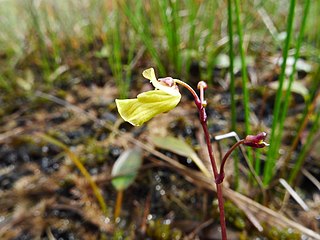
Utricularia ochroleuca, the yellowishwhite bladderwort, pale bladderwort, or cream-flowered bladderwort, is a small, perennial carnivorous plant that belongs to the genus Utricularia. It is usually found affixed to the substrate. U. ochroleuca is a circumboreal species and is found in North America, Asia, and Europe.
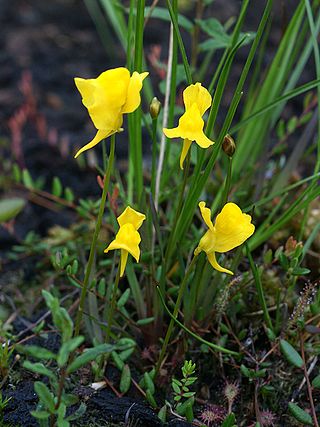
Utricularia cornuta, the horned bladderwort, is a small to medium-sized, probably perennial species of carnivorous plant in the family Lentibulariaceae. It is endemic to North America and can be found in the Bahamas, Cuba, Canada, and the United States. Utricularia cornuta grows as a terrestrial or subaquatic plant in marshes, swamps, and pools in shallow waters, mostly at lower altitudes. It was originally described and published by André Michaux in 1803.

Diphasiastrum complanatum, common names groundcedar, creeping jenny, or northern running-pine, is a species of clubmoss native to dry coniferous forests in colder northerly parts of the world. Under the original name Lycopodium complanatum, this was an inclusive superspecies that included a number of other species now known to be biologically separate. This plant is an evergreen, perennial pteridophyte. The spores are produced June to September.

Thlaspi californicum is a rare species of flowering plant in the family Brassicaceae known by the common name Kneeland Prairie penny-cress. It is endemic to California, where it is known from only one stretch of grassland in Humboldt County. It is threatened by development. It is a federally listed endangered species of the United States.

Frasera caroliniensis, commonly known as American columbo or yellow gentian, is a herbaceous perennial of the gentian family Gentianaceae found in the deciduous forest of Southern Ontario and throughout the eastern and southeastern United States. It was previously known as Swertia caroliniensis.

Polypremum is a flowering plant genus in the family Tetrachondraceae. The genus contains the single species Polypremum procumbens, commonly known as juniperleaf or rustweed. Polypremum has also been placed in the various families Buddlejaceae, Loganiaceae, Rubiaceae, and most recently in its own Polypremaceae.
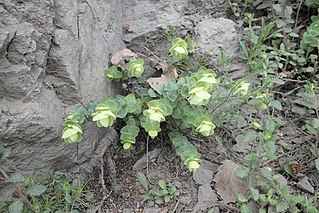
Origanum rotundifolium, the round-leaved oregano, is a species of flowering plant in the family Lamiaceae, native to Turkey, Armenia and Georgia. It is a small woody-based perennial or subshrub growing to 10–30 cm (4–12 in) tall by 30 cm (12 in) wide, with strongly aromatic leaves, and loose clusters of pink flowers with hop-like pale green bracts, throughout the summer.
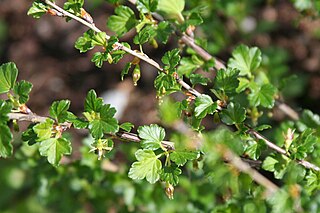
Ribes rotundifolium is a North American species of currant known by the common names wild gooseberry and Appalachian gooseberry. It is native to the eastern United States, primarily the Adirondacks, from Massachusetts and the Appalachian Mountains south as far as South Carolina and Tennessee.

















